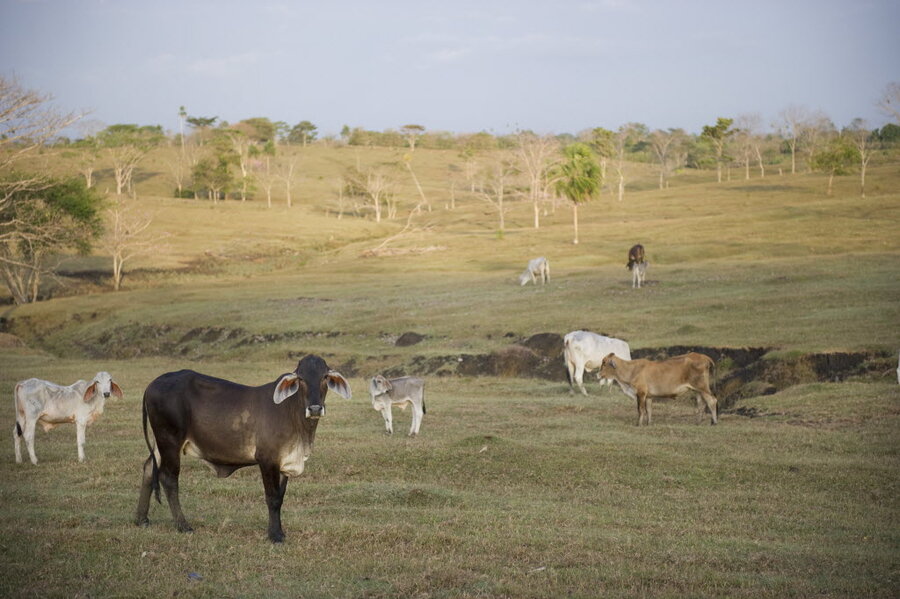How one group of plants help regrow an entire forest
Loading...
Legumes rise to meet the challenge of deforestation, scientists have found.
A team of researchers report in Nature that legumes, which fix atmospheric nitrogen into a useable form for other plants, grow faster than other trees in the earliest phase of a forest’s re-growth. The find highlights the pivotal role that just one group of plants – in collaboration with some useful bacteria – plays in growing up an entire forest that, as a carbon dioxide absorber, ultimately becomes the entire planet’s ally against global warming.
“This is a group of species that are helpers to the rest of the forest,” says Lars Hedin, a professor at Princeton University and a co-author on the paper.
“It’s super cool,” he adds.
For decades, the Americas’ forests, once unfurling like rumpled blankets across the continent, have been cut into to make room for booming cities and sprawling commercial farms and ranches. Those cuts, scientists note, have brought about the extinction of an unknown amount of species, as well as troubling losses in the ranks of an efficient carbon dioxide reducer: the tree.
Forests, as it is now well known, are prodigious sappers of the atmospheric carbon dioxide that would otherwise contribute to global warming. And as countries now work to replace the forests, bean or seed producing plants called legumes have been increasingly fingered as critical to the success of those efforts.
It has long been known that legumes are nitrogen fixers, converting atmospheric nitrogen into a soil-based version that plants depend on for growth, since tropical soil is, on its own, nitrogen-poor. The process begins with bacteria called rhizobia that take up residence in the plant’s root nodules (pods inside the tree's roots) to feed on the carbohydrates the plant manufactures. At the same time, the bacteria sequester nitrogen from the air and fix it into a form palatable to plants. Excess nitrogen in that process is churned into the soil, to the benefit of non-nitrogen-fixing plants.
But scientists have not been sure if that biological fixing process was enough to get forests going again, after the ecosystem had been culled for farmland and the soil degraded. The lack of nitrogen in the soil was thought to be a prohibitive factor in the chances of those forests – called second-growth forests – growing back.
The researchers studied 16 second-growth forests in Panama that had been turned back to the wild between five to 300 years ago. In the first 12 years of forest regrowth, legume plants were found to grow at nine times the rate of non-fixing plants. As a result, young forests that had been swaths of pasture just a dozen years earlier were found to have accumulated up to 50 percent of the carbon found in mature forests – about 50 metric tons of carbon per hectare, or some 185 tons of carbon dioxide. Legumes contributed about half of the nitrogen needed to grow the forest, the researchers found.
“We knew that legumes were important, but what surprised us was their ability to respond to nitrogen deficiency during the early phase of the regrowth,” says Sarah A. Batterman, a postdoctoral researcher at Princeton.
As the forests aged, the legumes gradually fixed less and less nitrogen, likely because fixing is an energy consuming process that puts the plants at a competitive disadvantage against other undergrowth, says Dr. Hedin.
“It’s in their best interest to turn off the fixing,” he says, noting that, at the point the process slows or shuts down, the soil has welled up enough nitrogen to sustain a nitrogen cycle and functional forest growth.
“These are really smart trees,” he adds.
The nine different species of legumes studied also began and stopped fixing nitrogen at staggered times, as if choreographed to keep the forest nitrogen-fed, the scientists found, noting that the research once again underscores the importance of biodiversity in the health of tropical forests.
Though the results are encouraging in suggesting that tropical forests are primed with the knowhow to make comebacks, that does not mean that all is well for the Americas’ rainforests, the researchers said.
“Tropical forests are still very much threatened,” says Hedin.








